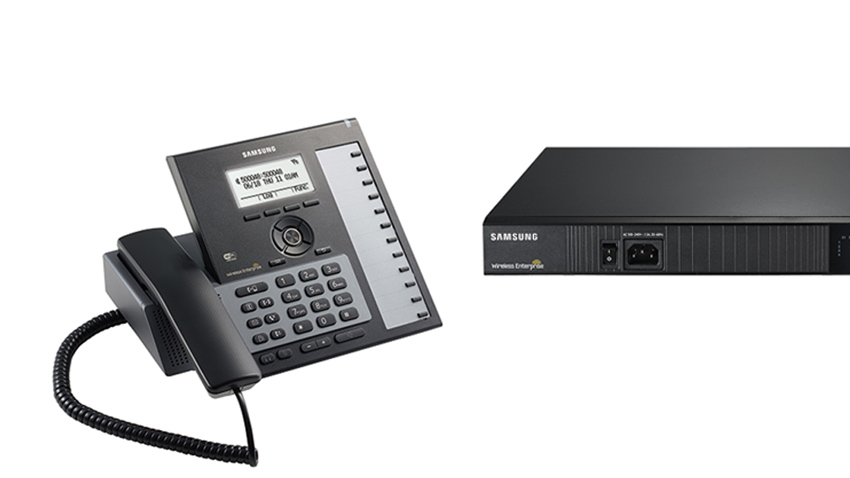For most of the past decade, Samsung has been making headlines for the almighty battle it has been locked in with Apple for dominance of the global mobile market.
With the scale of its interests in the consumer telecommunications market, it makes sense that the South Korean electronics conglomerate should also have a stake in business communications. And given the focus of its consumer telecoms operations, it is no surprise that its business arm should share a similar preoccupation – mobility.
The Samsung Communication Manager (SCM) Compact IPX-S300 is nominally an IP-PBX solution for the SME to lower mid-market. But in its positioning and marketing of the product, Samsung plays heavily on its ability to “cost effectively and efficiently solve mobility management challenges”. The solutions the SCM Compact offers, claim Samsung, are aimed at “helping businesses become more agile, improve operational efficiencies and enhance customer satisfaction.”
Taking its cue from what it calls the “mobile-first economy”, Samsung markets the SCM Compact as the ideal solution for Bring Your Own Device (BYOD) mobile integration, with a range of built in system management options which allow employees to work on their own devices flexibly and securely.
The WE VoIP application turns any mobile device into into an IP phone operating on the SCM Compact network, with full access to its features. It operates via mobile data 4G/LTE, but also over WiFi. Wireless capability is another key point Samsung focus on, arguing that the ability to run the SCM Compact as a full IP-PBX over its advanced WiFi solutions can potentially save customers thousands in cabling, installation and operating costs.
So, how well does the SCM Compact deliver on these claims? In this review we will look under the hood at what Samsung’s mobility and wireless solutions mean in practice for customers. Please remember that this review is the opinion of the author and is solely intended to provide information to our readers – UC Today does not endorse any particular brand or product.
How Does It Look?
The SCM Compact main unit is a 19” chassis with a particularly slender profile – its full dimensions are 441.5mm x 352mm x 44 mm. As is the style on modern IP-PBX units, the connection points on the front of the console are kept to a minimum – there are four main slots, three WAN/LAN I/F and one USB. There is then also a power supply unit connection.
Option cards can be added for four FXS ports and four FXO ports, one 23-channel PRI port and two 46-channel PRI ports, plus 3- channel VM/AA and 32-channel conference. An expansion cabinet is available, the same dimensions as the main unit, with either 20 FXS ports with single or dual power or 40 FXS ports with distributed power.
What Can It Do?
The SCM Compact IPX-S300 can support up to a maximum of 512 user endpoints with 128 available SIP trunks. However, it is designed to be easily networked to other Samsung servers and become part of a much larger system.
For example, it offers easy integration with the SCM Enterprise unit, which can run up to 3000 users across multiple sites. But as well as future proofing investments with such wide scope for scalability, the SCM Compact also offers backwards compatibility with legacy analogue and digital telephone systems. With media gateway expansion cards and the expansion unit, it can provide numerous analogue FXS/FXO and digital PRI interfaces, so existing telephone endpoints can still operate in tandem with the IP system.
In terms of hardware, the SCM Compact is compatible with Samsung’s SMT-i5000 and SMT-i6000 series of IP Phones. In keeping with Samsung’s focus on mobility discussed above, these ranges include WiFi and Bluetooth enabled endpoints which offer maximum flexibility around the workplace.
Mobile phones are also readily integrated as part of the SCM Compact network, and can be used as fully functioning IP office phones via the WE VoIP app. WE VoIP is available on Android and iOS and makes the full range of SCM PBX features available to mobile users, including conference calls, call transfer, call recording and call back.
WE VoIP also provides access to the SCM Compact’s advanced wireless transfer protocols intended to make WiFi telephony in the workplace smoother and more user friendly. Call Move allows for easy one touch transfer of calls between a desktop and mobile device, while Smart Handover seamlessly transfers calls being taken on a mobile to 4G when the user goes out of WiFi range. Used together, these features allow a user to start a call on their desktop and finish it out of the building on their mobile if they need to.
In addition, Smart Routing will automatically detect if calls between employees are being made on mobile networks or PSTN lines, and transfer them to IP extensions to save call costs. It also provides a direct link between desktop and mobile devices, routing calls to a user’s mobile if they are not at their desk.
The advanced WiFi telephony support is powered by Samsung patented WLAN technologies such as Airmove and Voice Aware Traffic Scheduling (VaTS). The ready mobile integration which supports BYOD is backed up by an inbuilt session border controller (SBC), providing enterprise class secure access to the network from any device, from any point, without the need for downloading VPNs on every device.
SCM Compact comes with a bundled suite of UC applications, all of which are accessible through the WE VoIP platform. These include voicemail, ACD application for Contact Center, automated attendant, call recording, conferencing and video calling. There are six channels each available for voicemail and ad-hoc conferencing, which can be expanded via an optional card.
In addition to the bundled UC applications available, the SMC Compact also offers built in set of APIs, including SIP, CSTA, JTAPI and TAPI, enabling customers to configure their own integrations with the third party applications of their choice.
Finally, the IPX-S300 has a number of failover contingencies intended to keep a communications network running in all circumstances. These include the ability to switch calls over to PSTN when there is an IP server down in a networked system, and as an ultimate back up, the network is always available via WiFi and mobile.
What do we like?
The ability to switch seamlessly between desktop, WiFi and mobile networks even on the same call via Call Move, Smart Handling and Smart Routing is impressive. Despite the drop out issues posed by transferring from one router coverage area to another, Samsung has thrown its weight behind WiFi telephony and is developing advanced WLAN technologies to iron out the problems. With the prospect of running entire office PBX systems wirelessly and close integration with mobile, Samsung is offering glimpses of the full potential agility of future business telephone systems.
The inbuilt APIs are also a nice touch. The SCM Compact may not be the most feature rich system in terms of UC applications, but the ability for customers to programme compatibility with their own chosen platforms creates an additional layer of flexibility to bend the IPX-S300 to the needs of the individual business.
Who is it for?
Some of the marketing literature for the SCM Compact describes it as a ‘pure IP-PBX’, by which we take it to mean that the focus is very much on telephony. This is a solution for businesses who still want voice to be the frontman of its communications band, with just the basic UC add ons thrown in. With a maximum of 512 users, as a standalone unit it is a product aimed at the SME market, though probably the larger end of that. However, the networking options with the SCM Enterprise mean it is a unit which will find its way into the architecture of much larger, multisite enterprises.
It is a good option both for new entrants into IP telephony who want to still use their existing analogue and digital hardware, and those businesses looking for increased mobility and flexibility in their communications
What is it compatible with?
In terms of third party applications, the IPX-S300 comes with an inbuilt set of APIs for SIP, CSTA, JTAPI and TAPI and more.
UC Today Opinion
The second wave of mobile technologies has been by far and away the biggest development in telecommunications over the past decade. It seems almost inevitable that at some point in the not too distant future premises based business communications infrastructure and mobile will converge completely, so that everyone will effectively be working and communicating on mobile devices and wireless connections will be reliable and secure enough to provide full anywhere, anytime access.
Samsung clearly believe that is where we are heading and are testing out the solutions which could make it happen with the Samsung Communications Management range. The IPX-S300 is a great mobility solution for the growing small to medium sized business looking to implement or expand BYOD. If you are looking for something which turns your mobile into an office IP phone easily and affordably, and which will plug into your network via WiFi too, this is it.
Although the number of endpoints available places the SCM Compact in the SME to lower mid-market, there is no doubt that Samsung has made an effort to include enterprise level features. Built-in Session Border Controller (SBC) for simplified remote access security, inbuilt API and survivable branch gateway options are not your average fare in medium sized IP-PBX. But then again, why should the size of your business affect the quality of the service you receive.
What have your experiences been of the Samsung SCM Compact IPX-S300? Does your company use it, or perhaps you are a reseller stocking it? What are your thoughts on office PBX and mobile convergence? And is Samsung backing the right horse investing heavily in WiFi? Let us know your thoughts in the comments section below, and please feel free to share this article on social media.







